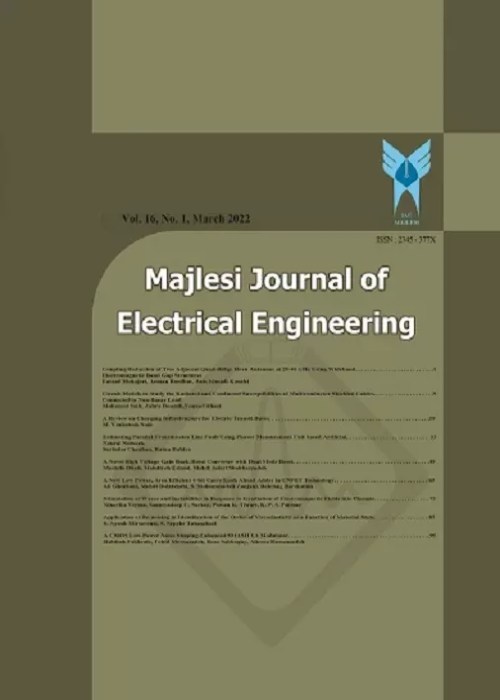فهرست مطالب
Majlesi Journal of Electrical Engineering
Volume:8 Issue: 2, Jun 2014
- تاریخ انتشار: 1393/04/31
- تعداد عناوین: 6
-
Pages 1-11Singular systems behave more powerfully in termsof dynamical system modeling than ordinary state space systems. Since thealgebraic equations in singular models can describe the systems constraints,nonlinear singular systems can present a general method for modeling andcontrol of constrained dynamical systems. This paper discusses an adaptivecontrol for nonlinear singular systems which satisfy Lipschitz condition. Adaptivemethods for singular systems are hardly ever investigated in literatures;however they are very useful methods in practice because the adaptive mechanismduring the adaptive control can adjust the controller for a system with unknownstructures and parameters to improve the system performance. The presentedcontroller is composed of a state feedback approach with adaptive gains and amechanism to adjust the gains based on the Lyapunov stability theorem. Firstthe controller is designed to stabilize the system then it is extended for the trackingproblem. A simulation on a mobile robot singular model is provided toillustrate the effectiveness of the proposed control approach
-
Pages 13-24Many real-world applications require minimization of a cost function. This function is the criterion that figures out optimality. In control engineering, this criterion is used in the design of optimal controllers. Cost function optimization has difficulties including calculating gradient function and lack of information about the system and the control loop. In this article, gradient memetic evolutionary programming is proposed for minimization of non-convex cost functions that have been defined in control engineering for the first time. Moreover, stability and convergence of the proposed algorithm are proved. Besides, it is modified to be used in online optimization. To achieve this, the sign of the gradient function is utilized. For calculating the sign of gradient, there is no need to know the cost function shape. The gradient function is estimated by the algorithm. The proposed algorithm is used to design a PI controller for nonlinear benchmark system CSTR (Continuous Stirred Tank Reactor) by online and off-line approaches.
-
Pages 25-31This paper presents new designing for robot that moves like worm and the structure of this robot is made by the Shape-Memory Alloy (SMA). Smart alloys and alloys in special kinds of artificial muscles apply motor action to the heat or cold in the construction of artificial muscles. This robot is controlled by the operator and computer. Imaging, position detection, smart guidance and environmental factors estimation such as height and impact are other abilities for this robot.
-
Pages 33-37A numerical technique based on Legendre Polynomials for finding optimal control of nonlinear systems with quadratic performance index is presented. An operational matrix of integration and product matrix are introduced and are used to reduce the nonlinear differential equations to the solution of nonlinear algebraic equations. The optimal solution of two classes of first and second order nonlinear systems is considered. In the case of second-order nonlinear systems, a new approach is introduced to find the optimal solution. In both cases, numerical examples are given and compared with the Taylor polynomial to confirm the accuracy of the proposed method.
-
Pages 39-44In this paper, a face recognition system, by using Contourlet transform (CT) as a two dimensional discrete transform and principal component analysis (PCA) as a sub-space method to form the feature vectors, is implemented. Any input image is decomposed by CT up to three levels and the CT coefficients are obtained at three scales and 15 orientations. The obtained CT coefficients are used by PCA to form the feature vectors. At the end, the Euclidean distance is used for classification. Our experimental results on ORL data base show the appropriate performance in comparison with other approaches even though for each subject only one image is used for training and other 9 images are used for testing. The average accuracy of our proposed algorithm for face recognition is 96.07%.
-
Pages 45-53In this article we investigate on robust mixed-sensitivity H∞ control for speed and torque control of induction motor (IM). In order to simplify the design procedure the Takagi–Sugeno (T–S) fuzzy approach is introduced to solve the nonlinear model Problem. Loop-shaping methodology and Mixed-sensitivity problem are developed to formulate frequency-domain specifications. Then a regional pole-placement output feedback H∞ controller is employed by using linear matrix inequalities(LMIs) teqnique for each linear subsystem of IM T-S fuzzy model. Parallel Distributed Compensation (PDC) is used to design the controller for the overall system. Simulation results are presented to validate the effectiveness of the proposed controller even in the presence of motor parameter variations and unknown load disturbance.


